By Maureen Smith
JACKSON – The Diocese of Jackson’s Faith in Action Team (FIAT) hopes to spur legislators to enact meaningful reform in the realm of mental health care for the state, using as a catalyst the Catholic Day at the Capitol on Wednesday, Jan. 17.
Advocates who attend the day will hear about the problems currently crippling the system and get some ideas for how to advocate for reform. Mississippi is currently facing a lawsuit for its lack of compliance with the 2009 Olmstead Supreme Court ruling which required states “to provide community-based treatment for persons with mental disabilities when… such placement is appropriate.”
“Mental illness affects everybody,” said Sue Allen, Catholic Charities’ coordinator of social justice ministry and the planner for Catholic Day at the Capitol. “The speakers we have coming are two of the most articulate and knowledgeable people about health care and the state of mental health care in Mississippi you could find. To be able to listen to them and ask questions of the panel we have put together is a unique opportunity,” she added.
To offer perspective on day-to-day issues involving mental health, FIAT has invited Angela Ladner, executive director of the Mississippi Psychiatric Association and Joy Hogge, executive director of Families as Allies, as the keynote speakers for the day. The agenda also includes a panel discussion which will include people who work in fields impacted by the lack of mental health care, the chaplain of Parchman State Penitentiary and a victims’ rights advocate.
Hogge said her organization is made up of families whose children face mental health challenges. It offers parent-to-parent support, insight for policy-makers and advocacy for children. “We want to help on a system-wide level so organizations can be more responsive.”
“Our main goal is that families are partners in their children’s care. It is essential that they can be partners,” explained Hogge. She said there is a movement within the mental health community to provide care in the community for those facing mental health challenges. “We want to start with family-driven care using the idea of starting with what they really want to achieve and to support the families in reaching those goals.” Hogge said that means making services flexible so, for example, someone can stay in school or remain employed while they are getting treatment. “That might mean supporting the employer,” she said. She will be speaking about some practical ways people can advocate for change.
Angela Ladner is the executive director of the Mississippi Psychiatric Association, a statewide medical specialty organization whose physician members specialize in the diagnosis, treatment and prevention of mental illnesses, including substance use disorders. Angela has persistently lobbied Mississippi lawmakers to make the necessary changes that will allow for more community-based treatment options.
The day starts at 9 a.m. at the Cathedral of St. Peter the Apostle’s parish center. This year, participants can ask questions and interact with the panelists during the discussions. In addition to the keynote and panel discussions, attendees will have the opportunity to participate in Mass, eat lunch together and attend a news conference on the capitol steps about the need for reform.
Those who wish can tour the capitol and speak with lawmakers.
The day will conclude with coffee at the cathedral center at 3 p.m. The day is free, but it is essential that people register so organizers will have enough lunches on hand.
Register online at https://www.catholiccharitiesjackson.org/parishsocialministry/cdc2018 or contact Sue Allen directly at (601) 355-8634 or sue.allen@catholiccharitiesjackson.org. Large groups are welcome.
Category Archives: Diocesan News
New class of deacons accepted as aspirants
By Deacon John McGregor
PEARL – On Saturday, January 6, during Mass at St. Jude Parish, Bishop Joseph Kopacz invited seven men from the Diocese of Jackson to begin the period of prayer and discernment to become permanent deacons. They will join the nine men already serving this diocese as permanent deacons.
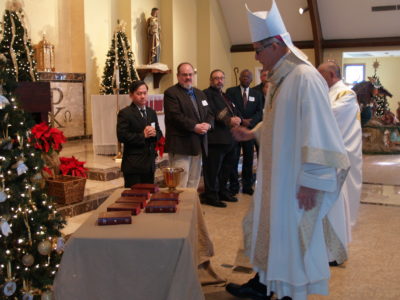
PEARL – Bishop Joseph Kopacz blesses brevaries for the seven men who entered the formation program for the permanent diaconate on Saturday, Jan. 6 at St. Jude Parish. The men will use the books to pray the daily prayer of the church, the liturgy of the hours. Visible are David Hoang, Mark Bowden, Kayed Jwainat and Wesley Lindsay. (Photos by Maureen Smith)
The aspirants are Mark Bowden (wife, Rhonda) from Pearl St. Jude Parish; Kayed Jwainat (wife, Cynthia) from Madison St. Francis Parish; John Anh Pham (wife, DiemThuy) from Forest St. Michael Parish; Tony Schmidt (wife, Karen) from Flowood St. Paul Parish; Edwin Antonio Wilson (wife, Kelleigh) from Magee St. Stephen Parish; and from the Cathedral of St. Peter the Apostle, David Hoang (wife, Honghuong) and Wesley Lindsay (not married).
This first year in the five-year process of formation is called aspirancy. During this time the aspirants meet monthly to hear talks on prayer, discernment and the ministry of the diaconate. This period is also a time for diocesan leadership to discern if the aspirants demonstrate and articulate an authentic call to ordination.
The process began when the candidates submitted a lengthy application including letters of recommendation. After all the documentation was received, each nominee and his wife were first interviewed by a diocesan permanent deacon and his wife and then by a diocesan priest. Following these two interviews, each candidate took a battery of psychological tests and interviewed with a psychologist. Finally, the candidates interviewed with the diocesan Diaconate Vocations Board, Father Kevin Slattery, the vicar general, and Bishop Kopacz.
On June 18, 1967, Pope Paul VI issued the Motu Proprio, Sacrum Diaconatus Ordinem restoring the diaconate as a permanent degree of holy orders. Although the permanent diaconate can trace its origins back to the Book of Acts, the diaconate eventually became a transitional rank for men who aspired to be priests. A man who enters the seminary and studies to become a priest, will be ordained a transitional deacon about a year before his ordination to the priesthood. A permanent deacon does not aspire to become a priest but rather chooses to remain at the service of the Church, in a special relationship with the bishop. A permanent deacon may be married or single and is at least 35 years of age but not older than 60 at the time of ordination.
The role of the wife is an essential part of the formation process. Not only is her consent and support necessary, she will share in her husband’s ministry. While the exact nature of the wife’s role varies widely, it is most effectively lived out in their ministry as husband and wife, committed to their marriage as the primary vocation in their lives, and to service to the Church as a natural part of the life-giving nature of their marital vocation.
Most permanent deacons have regular secular jobs in order to provide for their families. In addition to their secular work they are assigned by the bishop to serve the diocese in parishes, hospitals, schools, prisons and other places where their skills and the diocese’s needs coincide. Deacons are ordained for the works of word, liturgy, and charity. Their lives are one of commitment to the church as servants in imitation of Christ the servant.
Once the seven men complete the period of aspirancy, they may petition the bishop for admission to candidacy. The petitioner’s wife (if he is married) must also submit a handwritten letter of consent.
The petitioner will again be interviewed by the diaconate vocations board to appraise his readiness for nomination into the candidate path of formation. Those selected will then begin a four year formation process.
Like priestly formation, there are four dimensions to the formation of the diaconate: human, spiritual, intellectual and pastoral. In order for a man to be considered for the permanent diaconate, he must show that he has a stable marriage and home life as well as a stable job. His human development will be further evaluated to be sure that the formation process has a positive impact on his life and leads him to greater maturity as a Christian man.
The candidates must also meet regularly with a spiritual director and attend monthly spiritual formation conferences. They will also work with their pastor each of the four years in some aspect of diaconal pastoral ministry (e.g. catechesis, ministry to the sick, social outreach, etc.). The Diocese of Jackson has reached an agreement with Spring Hill College in Mobile, Ala., to help with the theological formation of the candidates. The candidates will be able to earn a Masters of Theological Studies through Spring Hill as part of their intellectual formation. Spring Hill will also assist the diocese in the spiritual formation of the candidates, drawing on its rich Ignatian spiritual heritage as a Jesuit institution.
Each year the candidates are expected to make a group retreat with their wives. This retreat will help them more clearly discern their calling, their area of ministerial service and their own spirituality.
The seven men who began their journey on January 6, after completing their formation process, are then eligible for ordination at the discretion of the bishop. Their ordination date would be sometime in the spring of 2022. Please keep these seven men in your prayers, as they discern their call and move through the process of formation.
(Deacon John McGregor is the director of the permanent diaconate for the Diocese of Jackson)
Bishop schedule
Sunday, Dec. 24, 5:00 p.m. – Vigil Mass othe Nativity of Our Lord, Jackson Carmelite Monastary
Friday, Jan. 5. 2018 – Mass, Diocesan Catholic School Employees, Madison St. Joseph
Saturday, Jan. 6, 2018, 9:00 a.m. Mass & Aspirancy Diaconate Candidates, Pearl St. Jude
Only public events are listed on this schedule and all events are subject to change.
Please check with the local parish for further details
Let it Snow: many celebrated Immaculate Conception under blanket of white
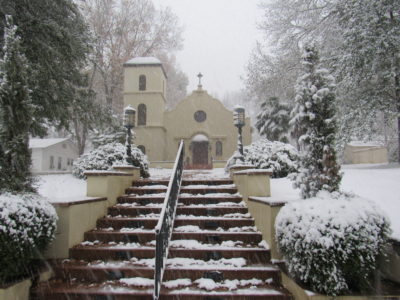
Philadelphia, Holy Cross
PHILADELPHIA – On Friday, Dec. 8, the Feast of the Immaculate Conception, a winter storm dropped five-to-six inches of snow in central Mississippi. Mississippi Catholic thanks all those who shared photos. Above, Holy Cross Parish looks like a postcard. (Photo by Clara Sims of Mississippi and the South)
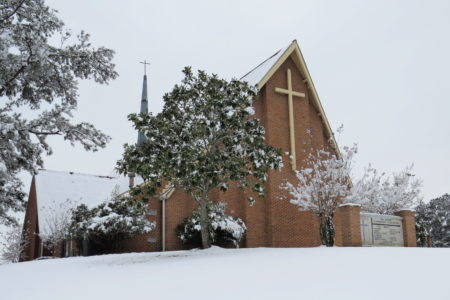
Pearl, St. Jude
PEARL – St. Jude Parish. (Photo by Rhonda Bowden)
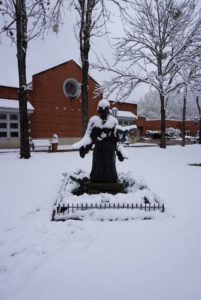
Madison, St. Francis
MADISON– St. Francis of Assisi. (Photo by Sallie Ann Inman)
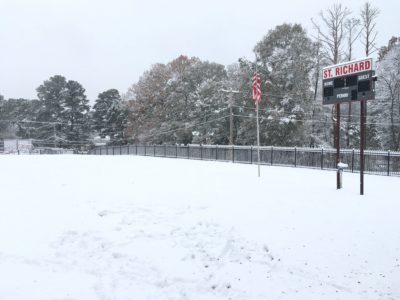
Jackson, St. Richard
JACKSON – St. Richard School’s football field was perfect for a snowball fight. (Photo by Jeff Amy)
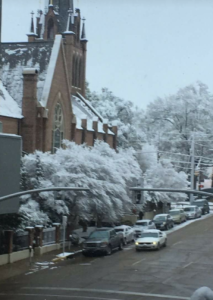
Jackson, Cathedral St. Peter
JACKSON – St. Peter Cathedral. (Photo by Joann Green)

Vicksburg, St. Michael
VICKSBURG – St. Michael’s Parish sign got a good dusting. (Photo by Helene Benson)
Father O’Connor to lead a tour to Ireland June 2018
By Father David O’Connor
Father David O’Connor, pastor at St. Mary Basilica and Assumption Church, Natchez, will lead a ten-day group trip to Ireland in June. The group – limited to 35 people – will depart from Jackson on Monday, June 25, and will return on Thursday, July 5. “The trip will be a guided tour of many of Ireland’s historic and scenic places,” said Father O’Connor.
The trip will include nine nights in Ireland. Each day will begin with a full Irish breakfast. Five dinners are included in the tour as well as a medieval banquet in a castle.
Highlights will include a sight-seeing tour of Dublin, including St. Patrick’s Cathedral which was founded in 1191, and Trinity College which houses the Book of Kells, as well as a visit to the Rock of Cashel, one of Ireland’s most spectacular archaeological sites featuring the ruins of a monastic settlement from the 13th century.
Father O’Connor himself will lead a tour of his hometown where he will celebrate Mass his home church. Another spiritual stop will be a visit to the village of Knock, where the Virgin Mary appeared in 1870.
“I will be with the group throughout their visit to Ireland, and will offer a tour of my home city of Limerick, where I will introduce the group members to the history and culture and myths of my native country. Our initial plan is for a group of approximately 30 people. This is my fifth time to lead a tour of my home country. My hope is that those who decide to make this tour will enjoy the natural beauty and history of Ireland and will return home with life-long memories and countless moments to savor from the land of saints and scholars,” Father O’Connor said.
(The package price, including airfare from Jackson, is $3,884.00 per person. Further information on the tour is available on the St. Mary website (www.stmarybasilica.org) or by contacting Cara Travel Services at info@caragrouptravel.com or 617-639-0273)
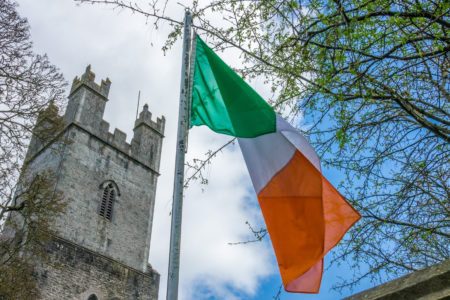
Irish flag fluttering in front of the tower of an Old St Mary Cathedral, Limerick, Ireland (Photo bigstock)
Advent a season of traditions, treasures at Saltillo Mission
By Msgr. Michael Flannery
MADISON – The months of November and December are exceptionally busy months at the Saltillo Mission. Mexican people have a great devotion to their deceased brothers and sisters. Mass is celebrated at the cemetery and each of the graves are blessed in turn by the priest.
People bring the favorite food of their loved ones and have a picnic at the cemetery and actually leave some food on the graves of their loved ones on all Souls Day, November 2. They adorn the graves with flowers. That same day begins a 40-day novena in in preparation for the Feast of Our Lady of Guadalupe, December 12, with the recitation of the rosary in each home with the whole family gathered around.
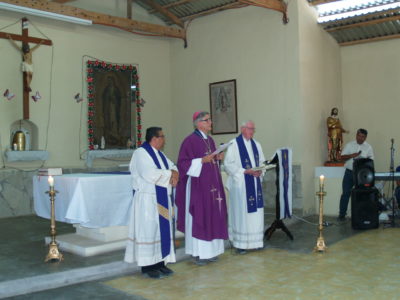
SALTILLO, Mexico – A priest from Saltillo, Bishop Joseph Kopacz and Msgr. Michael Flannery celebrate a Mass at the Mexican mission in April, 2017. An image of Our Lady of Guadalupe is visible in the background. (Photo courtesy Msgr. Michael Flannery)
For the celebration of the feast, all churches remain open starting at midnight. Various choirs, Mariachi bands and different groups go from church to church singing “Las Mañitas – a birthday song to Mary. The tradition is to begin with the local parish church and go from parish to parish and end up with a visit to the Sanctuary of Our Lady of Guadalupe. Every major city has a special shrine or sanctuary in honor of Our Lady of Guadalupe.
Following quickly on the heels of that feast is the celebration of Las Posadas beginning on December 16th. A posada is the Spanish word for “inn”. There is a long-standing tradition that it took Mary and Joseph nine days to travel from Nazareth to Bethlehem and each night they would request to stay at an inn. Usually, nine families pre-arrange to meet at nine homes and recite a para-liturgy and rosary commemorating the event. A meal is shared at the home of the host family for that particular evening.
When Christmas comes, the emphasis is on midnight Mass. The bells ring out in all the churches. Most families attend midnight Mass and then go from home to home in the neighborhood to celebrate Christmas. On Christmas day they usually sleep late after partying all night long. Most families will have a nativity scene in their homes. The custom is to leave that nativity scene there until March 19, which is the feast of St. Joseph.
It is against the law to cut trees in Mexico because of the limited supply of harvestable wood. Therefore, most homes have artificial Christmas trees. Christmas lights will adorn the tree and the Christmas presents are placed beneath. However, the sharing or distribution of Christmas gifts does not take place until the Feast of the Epiphany, January 6.
Tradition has it that the Magi took some time in following the star until eventually they arrived in Bethlehem. Between Christmas and Epiphany, each evening the children come to the parish church and participate in a para-liturgy and are given candy in anticipation of the arrival of the wise men. The Christmas presents are then distributed in each home with the celebration of Epiphany. These two months are full of prayer, activities and devotions.
(Msgr. Michael Flannery is a retired priest of the Diocese of Jackson. He served in Saltillo and this year wrote a history of the mission, once staffed by this diocese. Msgr. Flannery lives in Madison.)
La oficina del ministerio hispano, respondiendo a las necesidades de la comunidad hispana como expresaron el Plan Diocesano y en el V Encuentro, ofrecerá los siguientes cursos juntamente con el Instituto Pastoral del Sudeste:
 REQUISITOS
REQUISITOS
El programa está abierto a cualquier persona interesada en su formación católica.
El estudiante debe comprometerse a participar en todos los cursos y a pagar el costo completo aunque falte por alguna razón.
EMPEZAMOS LOS CURSOS TAN PRONTO QUE TENEMOS UN MINIMO DE 35 ESTUDIANTES.
Forma de pago:
Plan A: Pago completo ($160) – enero 27, 2018
Plan B Primer pago ($100) – enero 27, 2018
Segundo pago ($60) – marzo 24, 2018
Al cumplir estas clases, cada estudiante recibirá un certificado de la oficina del ministerio hispano.
Para más información:
Hermano Ted Dausch ted.dausch@jacksondiocese.org Teléfono: 601-672-9897
Hermana María Elena maria.mendez@jacksondiocese.org Teléfono: 769-274-5699
Hermana Josefina garcia.alvarez@jacksondiocese.org Teléfono: 601-405-9602
Reserva la fecha: El Día Católico en el Capitolio regresa en 2018
Por Maureen Smith
JACKSON – Caridades Católicas volverá a organizar el Día Católico en el Capitolio el miércoles 17 de enero de 2018. La salud mental es el tema para el evento. Angela Ladner de la Asociación Psiquiátrica de Mississippi y Joy Hogge de Mississippi Families as Allies son los oradores principales.
El Día Católico en el Capitolio fue fundado como una forma para que los católicos de todo el estado se dirijan a sus legisladores. Un equipo de Caridades Católicas identifica temas relacionados con la enseñanza social católica que los legisladores pueden tener en su agenda del año. El comité luego reúne recursos para aquellos que pueden abogar en nombre de la iglesia y aquellos que pueden verse afectados.
En los últimos dos años, el evento ha tenido un cambio de imagen. El equipo solía llamarse Poverty Task Force. Ahora se llama el Equipo de Fe en Acción (FIAT) y espera llevar la Enseñanza Social Católica al frente del trabajo de justicia social en toda la diócesis.
Sue Allen, coordinadora del ministerio de justicia social de Caridades Católicas de Jackson, ha estado viajando a las parroquias en cada decanato ofreciendo talleres sobre la doctrina social católica y sobre defensa en general. Ella cree que las personas empoderadas y educadas pueden hacer más al conocer a sus legisladores en casa que al llegar al capitolio durante la concurrida sesión. De esta manera, el Día Católico en el Capitolio se convierte en un día para que las personas se reúnan y aprendan sobre temas claves. Y lleven esa información a sus parroquias y comunidades, donde pueden abogar por una mejor atención para todos.
La inscripción se abrirá pronto en el sitio web de Catholic Charities. Busque en el próximo Mississippi Catholic una vista previa completa de los oradores y un calendario para el día.
Ospino hablará en eventos de la Semana Nacional de la Migración
Por Maureen Smith
Las parroquias en el noreste de Mississippi marcarán la Semana Nacional de la Migración, del 7 al 13 de enero de 2018, con cinco días de programación educativa, liturgia y celebraciones. La semana ofrece a los fieles la oportunidad de aprender más sobre los refugiados y los migrantes en su medio.
El presentador principal de la semana es el doctor Hosffman Ospino, profesor asociado de teología en Boston College, director del V Encuentro Nacional, miembro y asesor de la Asociación Nacional de Educación Católica y el USCCB. Ha escrito varios libros sobre el ministerio hispano y la identidad católica hispana.
Un comité compuesto por los ministros laicos Danna Johnson y Raquel Thompson y los pastores Padre Tim Murphy y Padre Mario Solarzano presentaron los programas.
“Cuando la Parroquia de San Cristóbal en Pontotoc fue parte del ministerio de los Misioneros de Glenmary, fue contactado por el Doctor Hosffman Ospino para ser parte de una encuesta nacional de iglesias con grandes poblaciones hispanas. El Doctor Ospino es uno de los expertos principales de prácticas del ministerio hispano, tendencias y planificación para el futuro ministerio en los Estados Unidos,” dijo el padre Murphy, pastor de Tupelo St. James.
“Nuestro Comité de Planificación ha utilizado su investigación y artículos. Le pedimos a Danna Johnson que se contacte con él y explorara la posibilidad de una presentación en el noreste de Mississippi. Más allá de todas las probabilidades, estuvo disponible durante la Semana Nacional de Migración 2018 y estuvo dispuesto a unirse a nosotros,” agregó.
PARA OBTENER MÁS INFORMACIÓN SOBRE LOS PROGRAMAS, LLAME A LA PARROQUIA AL 662-842-4881.
Feligreses celebran a Nuestra Señora de Guadalupe
Por Melisa Preuss-Muñoz
Las parroquias de la diócesis celebraron a Nuestra Señora de Guadalupe con procesiones, rosarios, bailes, misas, celebraciones y representaciones de “Las Mañanitas”. Nuestra Señora de Guadalupe, la patrona de las Américas, apareció como una princesa nativa a un hombre humilde e indígena, Juan Diego el 9 de diciembre de 1531. La Virgen solicitó que se construyera un santuario en su nombre, allí en la Colina del Tepeyac, el sitio de un antiguo templo azteca, que ahora es un suburbio de la ciudad de México. Cuando Juan Diego compartió las noticias con su obispo, no le creyó y pidió una señal.
El 12 de diciembre, Juan Diego regresó a la Colina de Tepeyac y la Virgen reapareció a él. Ella instruyó a Juan Diego a recoger rosas en su capa (tilmátli). Cuando regresó junto al obispo y abrió su manto para mostrarle las flores, docenas de rosas cayeron al suelo y se destapó la imagen en relieve de Nuestra Señora de Guadalupe. El tilmátli está ahora en exhibición en la Basílica de Guadalupe.
En 1859, la fiesta de Nuestra Señora de Guadalupe se convirtió en una fiesta nacional mexicana, ya que se dice que fue la inspiración principal que llevó a millones de indígenas al cristianismo.
